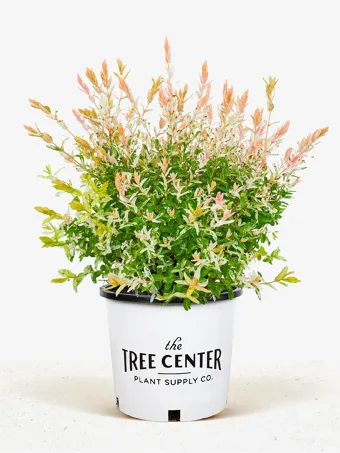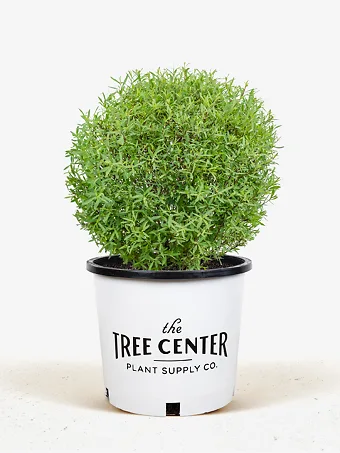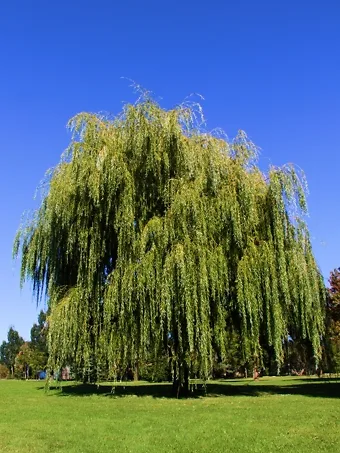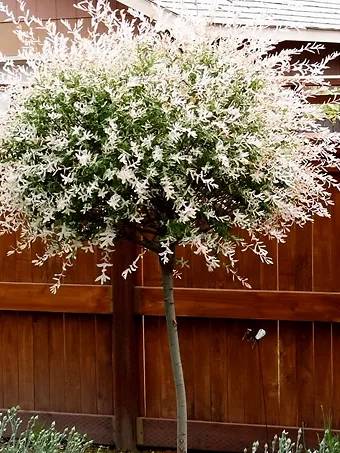
Written by s • Everything To Know Before You Buy Weeping Willow Trees
My grandmother’s house, in rural eastern Connecticut, is surrounded by farms and horses. It looks a lot different today than it did twenty years ago when, as a five-year old girl, my grandfather cut down the Weeping Willow that had gracefully adorned the front yard for generations. I’d heard stories about that tree: aunts who’d climbed and put on lipstick in its boughs and magical fairies that lived in its gnarled, fractured bark and layered root systems. Alas, I was too young to climb that tree when it came down, but the memory of it has meandered its way into my heart. The Weeping Willow is only one variety of the Willow family, of which there are approximately 400 species. From shrubs to swaying mammoths, the Willow family encompasses a match for you.
Willows grow best east of the Mississippi River, though some varieties have strayed their way down to the Midwest, Texas, Oklahoma, and even parts of central and southern California. The Willow Tree is resilient; some varieties will even re-root from cut off branches. Best in full sun with access to plenty of water, the Willow will add provide a gentle peace to the yard in which it is planted. Between its many varieties, the Willow can grow between 2 inches and 65 feet. Whether it is the grassy shrubs of the Dwarf Willow or the meditative boughs of the Weeping Willow, the Willow Tree varieties are sure to delight.
Quick Tips
Enjoy some quick tips here. For more complete information, read about these hints in more detail below.
Sunlight – Plant in full sun, allowing the tree to obtain some partial shade at times. Full sun encourages the plant to grow more fully.
Soil – Plant in well-drained, wet soil. Frequently found in the wild along creeks, streams, and rivers, the tree will do well in acidic, alkaline, and other soil varieties from sand to loam.
Water – Plant in evenly moist to wet soil, with access to constant water resources if possible. Irrigation will be necessary if it is planted in sandy or drier soils.
Pruning – Pruning can be done throughout the year. Resilient, the tree will be urged to grow new, green healthy growth.
The Best Places to Plant a Willow Tree
The Willow Tree, though surprisingly resilient and adaptive, is a bit picky. Although stunning and full of grace, the Willow does not do well in urban or dry environments. Willow Trees require full sun and plenty of access to water. This may not come easily. Since its leaves are small and lateral, sun is an important factor in gaining the fast growth for which these trees are known. Willow Trees are desirable in areas prone to erosion, as they grow well on the banks of streams or lakes. The roots will take hold, at times growing aerially till they find fitting soil and new water.
Willow Trees’ need for balance is essential. Explore your property to find areas where the soil is wet and the sun is strong. Underground streams may reside in your area, and these can make an enormous difference to the Willow Tree. Take a handful of soil from below the top layer of earth and squeeze. If the soil clumps or water emerges, the soil should be a good fit.
Do not despair if the soil is a dry. If your heart is set on a Willow (as is mine), then simply employ the use of judicious irrigation systems. Underground irrigation systems work well for Willow Trees, though sprinkler systems can work, too. The Willow Tree will, no matter which way you plant it, require a great deal of water.
Additionally, the Willow Tree you plant may have slightly different needs based on its variety. The Weeping Willow, which is most popular, thrives on the conditions mentioned above, but alternative varieties, such as the Bayberry Willow and Prairie Willow, are more resistant to drier soil or inconsistent water access. With its 400 varieties, you are sure to find one that can add some peaceful charm to your abode.
Growth Rate and Mature Height
The Willow Tree can be inconsistent in height. The tiny Dwarf Willow, reaching a diminished height of only 2 inches, grows almost as a grass in flood plains, whereas the Weeping Willow can grow up to 65 feet in height and spreads out to at least 40 feet in width. Willows are fast-growing, and grow best when in full sun with access to water, gaining more than 10 feet a year.
The Willow Tree Invasion
The Willow Tree is not classified as an invasive species, but it may very well be on its way there. These trees grow quickly, and some states, such as California, have issued warnings that these trees should only be planted in rural areas. The reason my grandfather uprooted the gentle giant of my youth? The tree’s roots had begun to damage the sewage tanks in their home. Willow Trees are beautiful and graceful, but as with all of nature’s beauty, they must be respected.
Variants of the Willow Tree
The genus Salix refers to over 400 varieties of trees, all of them Willows. From the Red Willow (Salix laevigata) to the Silky Willow (Salix sericea), or from the Alaskan Bog Willow (Salix fuscescens) to the Almond-leaved Willow (Salix triandra), the Willow family is sure to have a variety suited to your aesthetic desires. Different varieties grow better with variances in water access, soil type, and sun availability, so find a Willow that is sure to grow in your location.
Curing Headaches Since at Least the 5th Century B.C.
You may notice the similarity between the genus name Salix and the root word for salicylic acid (don’t worry if you didn’t). This is because the leaves and bark of the Willow contain salacin, which is metabolized into salicylic acid, providing temporary, albeit nauseating, relief from headaches. In 1897, Felix Hoffman was able to use the stories of the ancient Assyrians, Sumer, Egyptians, and Native Americans, as well as the work of both the Reverend Edward Stone and Henri Leroux, to synthesize an altered version of salacin. His new creation, named acetylsalicylic acid, is what we now know as aspirin. The next time you have a headache, thank the Willow you’ve planted in the front yard.
Noteworthy Tips on the Willow Tree
– Willow Trees are a common theme in many mythologies, religious ceremonies, and folktales, often providing other-worldly advice, a gentle guiding voice, or even protecting people from evil.
– Jewish worshippers use the Willow on the holiday Sukkot.
– For Buddhist worshipers, the Willow characterizes Kwan Yin, representing compassion.
– In China, Willow trees are thought to ward off evil spirits.









